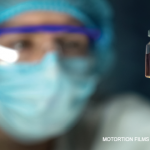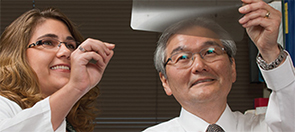
Dr. Yokoyama, MD, with Jennifer Laurent
In June 2014, 10 members of a church group returned to St. Louis from Haiti, where they had contracted chikungunya virus (CHIKV), a mosquito-transmitted alphavirus previously unknown in the Western hemisphere that produces inflammatory arthritis symptoms. Because CHIKV-related arthritis mimics seronegative RA, a group of clinicians, immunologists, virologists and geneticists at the Washington University in St. Louis Division of Rheumatology saw this cohort of patients as a unique opportunity. They assessed the patients’ clinical symptoms, laboratory features and immune cell phenotypes using cytometry by time of flight and compared them with healthy controls and patients with active RA. In their brief report, the authors report that they found that CHIKV-related arthritis is highly similar to RA, both in terms of clinical manifestations and laboratory features. They highlighted the need to consider patients’ travel histories when evaluating patients with symmetric polyarthritis.1
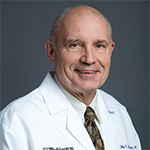
Dr. Atkinson
This interdisciplinary collaboration exemplifies the division’s strengths, says John P. Atkinson, MD, Samuel B. Grant Professor of Medicine, professor of molecular microbiology and chief of the Division of Rheumatology. With robust ties to the Departments of Pathology and Immunology, Molecular Microbiology and divisions in the School of Medicine, the rheumatology research program has advanced our understanding of the pathogenesis of multiple inflammatory diseases in its 53-year history.
Boasting premier research scientists—five of whom are or have been Howard Hughes Medical Institute Investigators, numerous former fellows and faculty who now head rheumatology divisions at their own institutions and a majority of faculty members who hold double appointments in research—the Division of Rheumatology continues to build on a foundation of scientific and clinical excellence.
The Beginnings
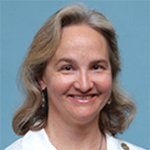
Dr. Parks
It was in 1962, according to a lively historical summary on the division’s website, that the division got its start. C. Kirk Osterland, MD, was charged with establishing the research/academic branch of the division within the Department of Medicine and Preventive Medicine. Robert Karsh, MD, took the reins of the clinical branch, joining the staff of Barnes [now Barnes Jewish] Hospital. (“Dr. Karsh is still active in academics and contributes to our Rheumatology Grand Rounds,” notes Dr. Atkinson.) Notable rheumatologists, including Bevra Hahn, MD, Benjamin D. Schwartz, MD, PhD, and Eng Tan, MD, spent their training and early faculty years there.
Strong collaborations with other Wash U divisions and the university’s remarkable tradition of basic science research augmented the division’s progress in building its
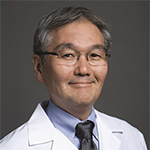
Dr. Yokoyama
emphasis on immunology, says Dr. Atkinson. There was “fortuitous overlap” with the Dermatology Department and skin biologists working on proteases, and with the pathology and the immunology programs. (Note: The latter two programs are now combined as the Department of Pathology and Immunology.) By the mid-1970s, when Dr. Atkinson came to St. Louis after his residency at Massachusetts General Hospital and post-doctoral work on the complement system at the NIH, “It became clear that immunology was going to dominate in rheumatology,” he says. Dr. Atkinson was given an HHMI investigator position and appointed director of the division in 1976.
Challenging Scientific Dogma
“There are many different strategies to advance knowledge in rheumatology and the rheumatic diseases,” notes Wayne M. Yokoyama, MD, professor of medicine, and of pathology and immunology, Sam J. Levin and Andrey Loew Levin Chair for Research on Arthritis, and investigator, Howard Hughes Medical Institute. He was recruited to Wash U’s School of Medicine in 1995 to head the division in the Department of Medicine. Dr. Atkinson was chair of the Department of Medicine at that time. Dr. Yokoyama saw the move as “a great opportunity to join an institution that already had a strong basic immunology research community.”
Dr. Yokoyama leads one of eight substantial research laboratories in the division and directs the Rheumatic Diseases Core Center, which is supported by the National Institute of Arthritis and Musculoskeletal and Skin Diseases (NIAMS). He is also a member of the National Academy of Sciences and the National Academy of Medicine (formerly the Institute of Medicine). Like Dr. Atkinson, Dr. Yokoyama is a recipient of the Lee C. Howley Prize for Research in Arthritis. He is prominently noted for his work on Ly49 receptors on natural killer (NK) cells, and the discovery of their intrinsic involvement in recognition of MHC Class I molecules, which “turn off” the NK cell, one of the first examples of inhibitory receptors on immune cells. That work was first begun relative to advancing the immune system understanding in cancer and led to breakthroughs in the immunologic bases of rheumatic and other autoimmune conditions.
“You don’t know where the advance will come from, or whether your work will have a bigger impact on a different disease, so having a broad perspective is useful,”
Dr. Yokoyama says. He also says his own post-doctoral and faculty mentors, such as Robert Ashman, MD, at the University of Iowa, Ethan Shevach, MD, at the NIH and Ira M. Goldstein, MD, at UCSF (who was also the first president of the newly renamed ACR), taught him “to do outstanding work and follow the data.”
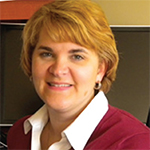
Dr. Lenschow
Encouraging rigorous technique and scientific independence pervades the Wash U program, observes V. Michael Holers, MD, who is the Scoville Professor and head of the Division of Rheumatology at the University of Colorado, Denver. The division has an “outstanding science program that teaches you to be an independent thinker and to do research that is often against current dogma,” says Dr. Holers, who was recently named to the NIAMS Advisory Council. He spent a total of 17 years at Washington University, from medical school to internship and residency to a research fellowship as an HHMI assistant investigator and associate professor.
The division has received NIH training grants for more than 40 years, allowing acceptance of post-doctoral candidates from around the world. Dr. Atkinson points out that fellows are not tethered to the division’s laboratories: “They can work in any lab in the entire university,” he says. Some have studied law and business or bioinformatics. “We give them tremendous leeway, and that helps attract certain kinds of individualistic high performers.”
For example, he points to Deborah J. Lenschow, MD, PhD, associate professor of medicine, who spent the majority of her postdoctoral lab training with a faculty member within the Department of Pathology and Immunology and not the Department of Medicine. She now directs a laboratory within the division aimed at investigating the interplay between viruses, innate immune regulators and autoimmune diseases. This includes elucidating the mechanism by which ISG15 exerts antiviral activity and regulates the innate immune response and translational and basic science studies focused on the pathogenesis of CHIKV-induced arthritis. She is also a teaching attending and with a colleague, Alfred Kim, MD, PhD, has instituted a basic immunology course for fellows.
In 2013, Dr. Kim inaugurated The Lupus Clinic at Washington University School of Medicine.
Collaborations Abound
The program’s commitment to clinical and basic immunology research training is manifest by several collaborations, says Dr. Atkinson. Those include a close connection with the Pediatric Rheumatology Program, run in concert with the Department of Pediatrics, and the Juvenile Idiopathic Arthritis Clinic at Shriner’s Children’s Hospital, a combined program with the VA Medical Center whose Rheumatology Group is headed by Amy Joseph, MD, as well as weekly Adult–Pediatric Grand Rounds and a weekly Translational Conference, both conducted at Barnes Jewish Hospital.
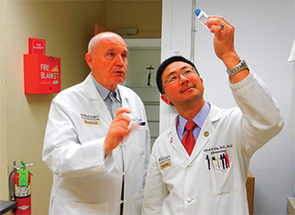
Dr. Atkinson and Dr. Kim.
David Karp, MD, PhD, Fredye Factor Chair in Rheumatoid Arthritis Research, Harold C. Simmons Chair in Arthritis Research and chief, Division of Rheumatology, University of Texas Southwestern Medical Center, also trained with Dr. Atkinson, among others, at Wash U. The program’s principal mission of training medical students, residents and fellows is also a testament to Dr. Atkinson’s approach, he says.
“John is a premier medical educator, and our residents and junior faculty who came from Barnes Hospital all talk about how much they learned from morning report and participating in rounds with him. He has that quality of taking any patient interaction and turning it into a wonderful teaching experience,” says Dr. Karp.
Professor Richard Brasington, MD, who has garnered multiple medical school teaching awards (Clinical Teacher of the Year in 2014 and recipient of many distinguished service teaching awards), is among other stellar clinicians at Wash U. Dr. Brasington is director of the Rheumatology Fellowship Program and a key mentor of fellows during their clinical training. He is also an associate editor of The Rheumatologist and will receive the Distinguished Fellowship Program Director Award at the 2015 ACR/ARHP Annual Meeting.
Maria Gonzalez-Mayda, MD, who recently joined the Wash U program as an assistant professor, says she chose to stay at Wash U after finishing her fellowship because, “The variety of cases at our institution on the inpatient and outpatient services continues to challenge me on a regular basis. I appreciate being able to discuss these cases with our senior faculty members at grand rounds and in the clinic.”
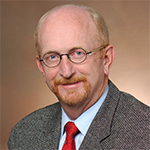
Dr. Holers
In addition, notes Dr. Karp, the intentional involvement of community rheumatol- ogists in monthly edu- cational meetings and training for residents has always been very strong.
Deborah Parks, MD, professor of internal medicine in the Division of Rheumatology, was recruited by Dr. Atkinson in 2011. She initiated a comprehensive, immersive musculoskeletal ultrasound training program (“ultrasound boot camp”) for the fellows, designed to teach guided and unguided synovial joint injections, as well as diagnostic musculoskeletal ultrasound. She is expanding that program for medical residents to learn point-of-care musculoskeletal ultrasonography.
Dr. Parks is also augmenting the division’s clinical services and, using administrative skills she acquired in the private sector, helping the division streamline its service delivery and reimbursements. She anticipates opening an additional outpatient rheumatology clinic in south St. Louis in 2016. Asked why she came back to the university after working in private practice, Dr. Parks said she welcomed the opportunity to devote time to expanding her ultrasound educational program. “And, when I trained here, Bevra Hahn, MD [now head of the Division of Rheumatology at UCLA and a lupus researcher], was my attending in internal medicine. It was she who turned me onto rheumatology. So coming back here is a chance to give something back.”

Dr. Gonzalez-mayda
In that tradition of giving back, Dr. Gonzalez-Mayda, who was born in Puerto Rico and is bilingual, decided to volunteer one weekend a month at Casa de Salud, a local nonprofit clinic, seeing rheumatology patients. She has also helped reach out to physicians in Columbia who have been dealing with a CHIKV epidemic, collaborating with Jonathan Miner, MD, PhD, to process blood and tissue samples of patients afflicted with the viral infection. “This can help us learn more about this serious infection with potentially devastating long-term consequences,” says Dr. Gonzalez-Mayda.
Dr. Lenschow believes that such innovations as the newly established Center for Human Immunology and Immunotherapy, directed by Robert Schreiber, PhD, will create “further opportunities for conducting human and translational research to link clinical immunology with the basic science that is so strong here.”
Gretchen Henkel is a medical journalist based in California.
Reference
1. Miner JJ, Aw Yeang HX, Fox JM, et al. Chikungunya viral arthritis in the United States: A mimic of seronegative rheumatoid arthritis. Arthritis Rheumatol. 2015 May;67(5):1214–1220.

